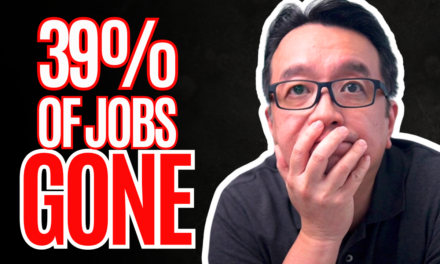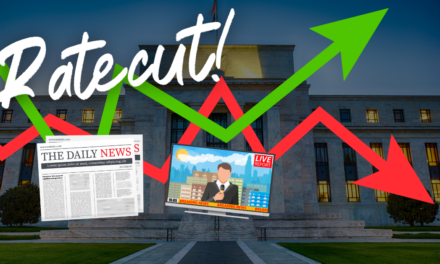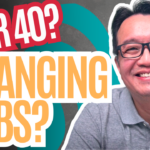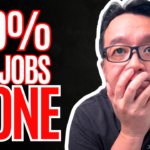
Cyclicals Surge, Growth Slides: Why I’m Sticking to My Strategy Amid Market Rotations


Cyclical stocks are on the rise while tech giants are losing steam—what does this mean for your portfolio? I break down the latest market shifts and why my approach remains steadfast, focusing on value, growth opportunities, and purpose-led investing.
During our recent weekly portfolio review for our students, I noticed something – there has been a shift in the the 5-year Earnings Per Share (EPS) forecasts by analysts for a good number of companies.
This caught my attention because the 5-year EPS forecast is an important metric that helps us gauge a company’s potential profitability over the next five years. Essentially, providing analysts forecasts of a company’s expected earnings growth, which directly affects valuations and, ultimately, share prices.
Recent revisions in the 5-year EPS growth estimates for Dow Jones companies seem to suggest a potential shift in market sentiment. Specifically, growing optimism in cyclical sectors, such as industrials and materials, while traditional growth sectors, particularly technology, are experiencing downgrades.
This shift suggests that investors may be adjusting their expectations, and looking for opportunities outside of high-growth tech stocks to explore more stable options.
What’s really strange for me is this – notable industry observers are indicating that the environment is currently ‘risk-on,’ citing rising interest in industrial commodities and emerging market assets. Prominent crypto analysts are also suggesting that digital assets are likely to follow suit.
In my mind, this seems contradictory, as a rotation away from growth and tech typically signals a move towards safety, whereas ‘risk-on’ sentiment implies a willingness to embrace higher risk across multiple asset classes.
In this confusing market environment, let’s dive deeper into what’s happening between cyclical and growth sectors and what it could mean for investors.
Understanding Cyclical and Growth Sectors
Before we explore the recent trends, it’s important to understand the difference between cyclical and growth sectors:
– Cyclical Sectors: These industries, which include energy, industrials, and materials, are heavily influenced by economic cycles. When the economy is expanding, cyclical sectors tend to perform well, benefiting from increased consumer and business spending. However, during economic downturns, these industries often struggle as demand contracts.
– Growth Sectors: Growth sectors, on the other hand, include industries such as technology and consumer discretionary. These sectors tend to perform well regardless of broader economic conditions, as they are driven by innovation, rising consumer demand, and their ability to create new products and services. Growth stocks are known for their ability to generate above-average revenue and earnings growth, even during times of economic uncertainty.
Downgrade in Growth Sectors…
One of the key trends we’re observing is the downward revision of growth estimates for several well-known technology companies. Let’s take a look at some specific examples:
– Amazon (AMZN): Revised down from 31.75% to 20.00%.
– Apple (AAPL): Revised down from 11.10% to 8.00%.
– Intel (INTC): Revised down from 20.98% to 15.71%.
These revisions suggest that growth expectations for some of the biggest tech companies are being tempered.

… Cyclical Sectors Are Gaining Momentum
While growth sectors are facing headwinds, cyclical sectors are seeing a more optimistic outlook:
– Caterpillar (CAT): Revised up from 5.30% to 8.38%.
– DOW (DOW): Revised up from 23.53% to 26.16%.
Market Rotation: Are Investors Seeking Stability?
Market rotations are normal occurrences in the financial markets, where investors shift their focus between different types of assets or sectors based on economic conditions and market sentiment. These rotations often happen as part of the natural ebb and flow of the economy, as investors seek out new opportunities or adjust their portfolios to manage risk.
In the current environment, we might be witnessing a rotation away from high-growth tech stocks toward more stable, value-oriented cyclical sectors.
Understanding these rotations can help investors make more informed decisions about where to allocate their capital.
What’s difficult to understand is the current market environment, where we are seeing a ‘risk-on’ sentiment while simultaneously rotating away from high-growth tech stocks. Typically, risk-on assets and growth sectors move in tandem, as both are driven by investor confidence and optimism.
However, in this case, the shift towards cyclical sectors, which are traditionally considered more stable, is occurring alongside a renewed willingness to embrace risk in other areas of the market. This ‘contradiction’ highlights the complexity of current investor psychology, as they balance the desire for higher returns with a cautious approach to growth – and the futility of trying to predict and pick sectors or even stocks!
What Does ‘Risk-On’ Mean?
In case you’re not familiar with the term ‘risk-on’ refers to a market environment where investors are willing to take on more risk in their investments, typically because they have a positive outlook on the economy and market conditions.
In a risk-on environment, investors are more inclined to buy assets with higher potential returns but also greater risk, such as speculative stocks, commodities, and other high-risk investments. This contrasts with a ‘risk-off’ environment, where investors seek safety in lower-risk assets, like bonds or cash, due to uncertainty or fear in the market.
Which is why I think the return of ‘risk-on’ assets in tandem with a rotation away from growth in favor of cyclical sectors is a contradiction, since growth stocks and risk-on assets are both driven by investor confidence and optimism.
Does it Really Matter to Investors?
For investors, the key question is: how should this information influence portfolio strategy?
– Focus on Long-Term Value: It’s important to focus on long-term value and growth rather than trying to capitalize on short-term trends. Market cycles come and go, but consistent growth over time is generally a more reliable strategy than trying to time the market.
– Capitalizing on Trends: That said, there are opportunities for investors to capitalize on shifts in market sentiment. If your investment strategy aligns with taking advantage of cyclical gains, now may be an opportune time to increase exposure to those sectors. However, it’s essential to weigh this against your overall financial goals and what you want from life – remember – watching trends can end up being a full time job (and it is for many). So, if you want more from life, then focus on Long-Term Value and…
– Purpose-Led Investing: Ultimately, investing should be about more than just returns. It’s important to keep your long-term and short-term purposes in mind across all your passive income streams. Whether you’re seeking financial freedom, a stable retirement, or the ability to live a more meaningful life, your investments should align with those goals. Wealth is afterall, just a means to live a much more meaningful life.

My Approach in this Confusing Market
As we navigate these shifting market dynamics, here’s what I’ll be doing:
Continue Monitoring My Portfolio: I will keep a close eye on my portfolio, paying attention to any significant changes in the market and adjusting as necessary.
Adding to My Favorite Growth Stocks: When my favorite growth stocks fall below their intrinsic value, I plan to continue adding to my positions. This strategy allows me to capitalize on temporary price drops while maintaining a long-term perspective.
Extracting Value at Peaks: When these growth stocks go above their fair value and exceed analysts’ expectations, I will look to extract value by either selling some shares or selling covered calls. This helps lock in gains and provides additional income through option premiums.
As you can see, my strategy has nothing to do with the current market rotation or risk-on sentiment.
Conclusion
In conclusion, while growth stocks might be slowing, cyclical sectors are showing resilience and potential for future growth. This market rotation, driven by rising interest rates, inflation, and increased infrastructure spending, is creating opportunities for investors to diversify their portfolios.
So, what do you think? Is it worth trying to capitalize on these short-term shifts, or should you stay focused on consistent, long-term growth? Share your thoughts—whether you’re shifting focus or staying the course, the right strategy will always depend on where you are in life and what you want to achieve.























Recent Comments